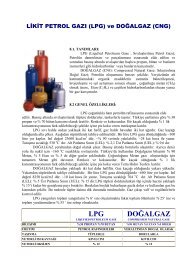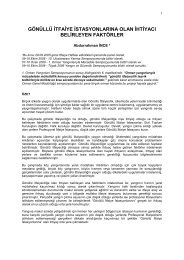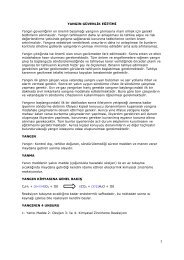buradan - Yangın
buradan - Yangın
buradan - Yangın
Create successful ePaper yourself
Turn your PDF publications into a flip-book with our unique Google optimized e-Paper software.
TÜYAK BİLDİRİLER KİTABI<br />
2009 PROCEEDINGS BOOK<br />
Hatem Ezzat KHEIR<br />
Kheir Group Egypt<br />
2<br />
TÜYAK 2009<br />
FIRE PUMP INSTALLATION COMMON MISTAKES<br />
Abstract<br />
The performance of fire pump depend not only on how you design,<br />
or test the pump, but also on the way and rules of installation, many<br />
consultants, and user think that NFPA20, the most famous code<br />
for fire pumps, is related only to the pump way of manufacture, but<br />
actually it is “Installation of Stationary Pumps for Fire Protection”<br />
as the installation is one of the main factor of assuring that the fire<br />
pump will perform as required.<br />
There are many common mistakes we can do during the installation<br />
based on common knowledge of installation normal water pump,<br />
which can effect badly the fire pump performance, and some time<br />
result of failure, or short life of the pump.<br />
<strong>Yangın</strong> Pompası Kurulumu İle İlgili Sık Olarak Yapılan<br />
Hatalar<br />
Özet<br />
<strong>Yangın</strong> pompasının performansı sadece pompayı nasıl tasarlayıp<br />
test ettiğinize değil aynı zamanda, kurulum şekli ve kurallarına<br />
da bağlıdır. Pek çok danışman ve kullanıcı, yangın pompaları<br />
ile ilgili en ünlü mevzuat olan NFPA 20’nin, sadece pompanın<br />
nasıl üretildiği ile ilgili olduğunu düşünürler ancak gerçekte, en<br />
önemli mevzuat, “<strong>Yangın</strong>dan Korumaya Yönelik Sabit Pompaların<br />
Kurulumu” başlıklı mevzuattır, çünkü, yangın pompasının istenen<br />
şekilde performans sergilemesini garantileyecek en önemli faktör<br />
kurulumudur.<br />
<strong>Yangın</strong> pompası kurulumu sırasında pek çok hata yapılmaktadır<br />
ve bu hatalar, normal su pompalarının kurulumu ile ilgili sahip<br />
olduğumuz genel bilgiden kaynaklanmaktadır. Bu hatalar,<br />
pompa performansını olumsuz etkileyebilir ve bazen pompanın<br />
bozulmasına veya kısa ömürlü olmasına sebep olabilir.<br />
1. The Main Factors<br />
Suction<br />
I personally believe that suction side of the fire pump is more than<br />
80% of good or bad fire pump, if you have proper suction conditions<br />
you achieved the 80% of required pump performance.<br />
1.1.Tank:<br />
Many users don’t take in consideration that “centrifugal pumps<br />
shall not be used where a static lift is required”<br />
When you have the pump room on the same level of the tank, or<br />
below the tank, you can use the centrifugal (horizontal, end suction,<br />
or inline), but when the pump room is above the water level of the<br />
fire water tank, you don’t have another choose, you need to go<br />
to vertical turbine pumps, you can’t use self priming type pump,<br />
fire pump stand still for more than a week before the weekly test,<br />
so you are subject of losing you water inside the suction line, or<br />
even inside the casing of self priming pump, and as most of the<br />
fire pump are automatic operation, you can’t stop the pump till you<br />
prime the pump.<br />
Figure 1. Horizontal Split-Case Fire Pump Installation with Water Supply<br />
under a Positive Head.<br />
1.2.Vortex Plate:<br />
One of the most important part of suction line for centrifugal<br />
pump, many users think that as long they have positive suction<br />
level in the fire water tank, he don’t need to have vortex plate, fluid<br />
calculations, and experience shows that even with positive water<br />
level, in certain water level you will have vortex which will result of





